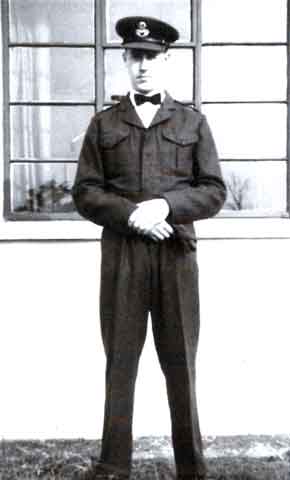my first night solo. Taking off and landing on a featureless (other than patches
marked as bad ground which couldn't be seen in the dark) grass airfield tended
initially to involve more good luck than flying skill. The 'runway' was a T-shaped
pattern of goose-neck flares laid out according to the wind direction at the time;
landing was on one side of the leg of the 'T' and take-offs on the other. Aldis lamp
signals and, in dangerous situations, Verey lights were the only visual means of
control in addition to the
R/T. The control tower couldn't see us properly in the dark
and couldn't readily distinguish one aircraft from another. A sharp - particularly
sharp - lookout was essential. There was a 'Chance Light' which, when switched on,
usually caused one (instructors included) to tend to 'land' about six feet above the
ground and thus hit the ground heavily for the real landing.
7 Airfields had 'Pundits'
in those days. These were red beacons which repeatedly flashed an airfield's identity
in Morse Code. When it came to night navigation these were an enormous
help. But I had a problem. I had a complete block when it came to learning Morse Code. To me it was like
trying to sight-read Chinese without previous knowledge. I got by in ground
school at four words a minute provided the words were short. In the air I had a
piece of paper carrying the code fastened to my right knee where I could
always refer to it. Neither Morse code nor calculations came easily to me when
airborne. To navigate by both day and night I relied heavily on my strong
inbuilt sense of direction and have to say that I never got lost, even in or
above cloud.

One day, quite unexpectedly, we
were all gathered together by the
CO and told that we would be taking part
in an Escape and Evasion exercise as defenders of a make-believe country
called Lestrutshire which was the combined area of the counties of
Leicestershire and Rutland. As defenders we were to be on guard at
what we were told would be critical locations past which escaped 'foreign'
airmen were supposed to be making their way to a 'safe house'. The
'foreigners' were none other than trainee pilots from other airfields.
Defenders were made up of Police, Army, RAF, and Civil Defence personnel. Our
stint found us, late one chilly summer night, being bussed to some strange location
where there was a bridge on a main road in a housing estate which was regarded as
'important'. None of us saw anything at all suspicious, and the night was only memorable for our acute tiredness and
the shivering cold in the hour immediately following sunrise. To us, it was a total
waste of time and taught us nothing.

In National Service Mess Kit outside my room
window before going to a Dining In Night.
__________________________________
7 Chance Light = The commercial name for a unidirectional floodlight which could be switched on to shine a beam
along the landing side of the flare path.
20








